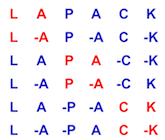179 SUBROUTINE slasq3( I0, N0, Z, PP, DMIN, SIGMA, DESIG, QMAX, NFAIL,
180 $ ITER, NDIV, IEEE, TTYPE, DMIN1, DMIN2, DN, DN1,
189 INTEGER I0, ITER, N0, NDIV, NFAIL, PP
190 REAL DESIG, DMIN, DMIN1, DMIN2, DN, DN1, DN2, G,
201 parameter( cbias = 1.50e0 )
202 REAL ZERO, QURTR, HALF, ONE, TWO, HUNDRD
203 parameter( zero = 0.0e0, qurtr = 0.250e0, half = 0.5e0,
204 $ one = 1.0e0, two = 2.0e0, hundrd = 100.0e0 )
207 INTEGER IPN4, J4, N0IN, NN, TTYPE
208 REAL EPS, S, T, TEMP, TOL, TOL2
216 EXTERNAL sisnan, slamch
219 INTRINSIC abs, max, min, sqrt
224 eps = slamch(
'Precision' )
242 IF( z( nn-5 ).GT.tol2*( sigma+z( nn-3 ) ) .AND.
243 $ z( nn-2*pp-4 ).GT.tol2*z( nn-7 ) )
248 z( 4*n0-3 ) = z( 4*n0+pp-3 ) + sigma
256 IF( z( nn-9 ).GT.tol2*sigma .AND.
257 $ z( nn-2*pp-8 ).GT.tol2*z( nn-11 ) )
262 IF( z( nn-3 ).GT.z( nn-7 ) )
THEN 264 z( nn-3 ) = z( nn-7 )
267 t = half*( ( z( nn-7 )-z( nn-3 ) )+z( nn-5 ) )
268 IF( z( nn-5 ).GT.z( nn-3 )*tol2.AND.t.NE.zero )
THEN 269 s = z( nn-3 )*( z( nn-5 ) / t )
271 s = z( nn-3 )*( z( nn-5 ) /
272 $ ( t*( one+sqrt( one+s / t ) ) ) )
274 s = z( nn-3 )*( z( nn-5 ) / ( t+sqrt( t )*sqrt( t+s ) ) )
276 t = z( nn-7 ) + ( s+z( nn-5 ) )
277 z( nn-3 ) = z( nn-3 )*( z( nn-7 ) / t )
280 z( 4*n0-7 ) = z( nn-7 ) + sigma
281 z( 4*n0-3 ) = z( nn-3 ) + sigma
291 IF( dmin.LE.zero .OR. n0.LT.n0in )
THEN 292 IF( cbias*z( 4*i0+pp-3 ).LT.z( 4*n0+pp-3 ) )
THEN 294 DO 60 j4 = 4*i0, 2*( i0+n0-1 ), 4
296 z( j4-3 ) = z( ipn4-j4-3 )
297 z( ipn4-j4-3 ) = temp
299 z( j4-2 ) = z( ipn4-j4-2 )
300 z( ipn4-j4-2 ) = temp
302 z( j4-1 ) = z( ipn4-j4-5 )
303 z( ipn4-j4-5 ) = temp
305 z( j4 ) = z( ipn4-j4-4 )
306 z( ipn4-j4-4 ) = temp
308 IF( n0-i0.LE.4 )
THEN 309 z( 4*n0+pp-1 ) = z( 4*i0+pp-1 )
310 z( 4*n0-pp ) = z( 4*i0-pp )
312 dmin2 = min( dmin2, z( 4*n0+pp-1 ) )
313 z( 4*n0+pp-1 ) = min( z( 4*n0+pp-1 ), z( 4*i0+pp-1 ),
315 z( 4*n0-pp ) = min( z( 4*n0-pp ), z( 4*i0-pp ),
317 qmax = max( qmax, z( 4*i0+pp-3 ), z( 4*i0+pp+1 ) )
324 CALL slasq4( i0, n0, z, pp, n0in, dmin, dmin1, dmin2, dn, dn1,
325 $ dn2, tau, ttype, g )
331 CALL slasq5( i0, n0, z, pp, tau, sigma, dmin, dmin1, dmin2, dn,
332 $ dn1, dn2, ieee, eps )
334 ndiv = ndiv + ( n0-i0+2 )
339 IF( dmin.GE.zero .AND. dmin1.GE.zero )
THEN 345 ELSE IF( dmin.LT.zero .AND. dmin1.GT.zero .AND.
346 $ z( 4*( n0-1 )-pp ).LT.tol*( sigma+dn1 ) .AND.
347 $ abs( dn ).LT.tol*sigma )
THEN 351 z( 4*( n0-1 )-pp+2 ) = zero
354 ELSE IF( dmin.LT.zero )
THEN 359 IF( ttype.LT.-22 )
THEN 364 ELSE IF( dmin1.GT.zero )
THEN 368 tau = ( tau+dmin )*( one-two*eps )
378 ELSE IF( sisnan( dmin ) )
THEN 382 IF( tau.EQ.zero )
THEN 398 CALL slasq6( i0, n0, z, pp, dmin, dmin1, dmin2, dn, dn1, dn2 )
399 ndiv = ndiv + ( n0-i0+2 )
404 IF( tau.LT.sigma )
THEN 407 desig = desig - ( t-sigma )
410 desig = sigma - ( t-tau ) + desig
subroutine slasq3(I0, N0, Z, PP, DMIN, SIGMA, DESIG, QMAX, NFAIL, ITER, NDIV, IEEE, TTYPE, DMIN1, DMIN2, DN, DN1, DN2, G, TAU)
SLASQ3 checks for deflation, computes a shift and calls dqds. Used by sbdsqr.
subroutine slasq5(I0, N0, Z, PP, TAU, SIGMA, DMIN, DMIN1, DMIN2, DN, DNM1, DNM2, IEEE, EPS)
SLASQ5 computes one dqds transform in ping-pong form. Used by sbdsqr and sstegr. ...
subroutine slasq6(I0, N0, Z, PP, DMIN, DMIN1, DMIN2, DN, DNM1, DNM2)
SLASQ6 computes one dqd transform in ping-pong form. Used by sbdsqr and sstegr.
subroutine slasq4(I0, N0, Z, PP, N0IN, DMIN, DMIN1, DMIN2, DN, DN1, DN2, TAU, TTYPE, G)
SLASQ4 computes an approximation to the smallest eigenvalue using values of d from the previous trans...

